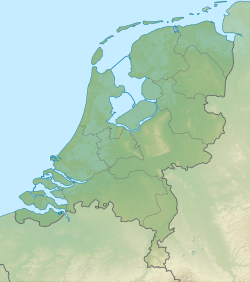The 1992 Roermond earthquake occurred on 13 April, around 3:20 AM (1:20 UTC) with a moment magnitude of 5.3 and a maximum Mercalli intensity of VIII (Severe).[2] Striking on the Peel Boundary Fault, a normal fault near Roermond, it was the strongest recorded earthquake in the Netherlands and in Northwestern Europe, and caused substantial damage to older buildings in the Netherlands and adjacent countries of Belgium and Germany. A series of aftershocks followed.
| UTC time | 1992-04-13 01:20:00 |
|---|---|
| ISC event | 295572 |
| USGS-ANSS | ComCat |
| Local date | 13 April 1992 |
| Local time | 03:20:00 |
| Magnitude | 5.8 ML 5.3 Mw[1] |
| Depth | 18.0 km (11.2 mi)[1] |
| Epicenter | 51°10′N 5°57′E / 51.16°N 5.95°E[1] |
| Type | Dip-slip |
| Areas affected | Netherlands, Germany and Belgium |
| Max. intensity | MMI VIII (Severe)[2] |
| Casualties | 1 dead, 46 injured[3] |
Tectonic setting
editThe city of Roermond lies above the Roer Graben, which forms the southeastern part of the Lower Rhine Graben (or Lower Rhine Embayment). These structures form part of the European Cenozoic Rift System, which formed within the foreland of the Alpine orogeny. The Roer graben formed during the Paleogene and is currently active as shown by the thickening of Quaternary sedimentary rocks into the basin. The graben is bounded by NW-SE trending normal fault systems, with the largest fault being the southwest-dipping Peel Boundary Fault, which displaces the base of the Quaternary sequence by about 175 m.[4] All the major faults show evidence of neotectonics.[5]
Location
editThe earthquake's focal mechanism showed almost pure normal faulting on a plane dipping southwest at 68°, identified as the Peel Boundary Fault.[6] The epicentre of the earthquake lay kilometers away from the south of Roermond.
Intensity
editThe earthquake was recorded as 5.8 on the Richter scale (5.3 on the moment magnitude scale) and a maximum intensity of VIII (Severe) on the Mercalli intensity scale.[7]
An intensity of VIII means considerable damage to poorly built structures and heavy furniture is overturned.[8] The earthquake was not evenly spread as some areas were hit harder than others. This earthquake could be felt as far away as the Czech Republic, Switzerland, France and England.[7]
Damage and casualties
editIn the regions between Roermond, Maaseik (Belgium), and Heinsberg (Germany), buildings, especially old buildings, and cars were destroyed.[7] Two churches in Roermond, the Munsterkerk and Minderbroederskerk, were heavily damaged.[9][10] The economic cost of the earthquake was estimated to be around 275 million guilders (around 125 million euros), of which 170 million guilders (around 77 million euros) of damage in the Netherlands.[7] A 79-year-old woman died of a heart attack in Bonn.[3]
Aftershocks
editThe earthquake was followed by more than 200 aftershocks.[11]
See also
editReferences
edit- ^ a b c "An earthquake catalogue for central, northern and northwestern Europe based on Mw magnitudes / Annex. STR 03/02" (PDF). GeoForschungsZentrum Potsdam. p. 142. Retrieved 20 February 2015.
- ^ a b "M 5.4 – 1 km W of Kessenich, Belgium". USGS-ANSS. Retrieved 23 August 2021.
- ^ a b "Rare European Quake Leaves 1 Dead, 46 Hurt". The New York Times. Associated Press. 14 April 1992. Retrieved 23 August 2021.
- ^ Braunmiller J., Dahm T. & Bonjer K-P. (1994). "Source mechanism of the 1992 Roermond earthquake from surface- wave inversion of regional data" (PDF). Geophysical Journal International. 116 (3): 663–672. Bibcode:1994GeoJI.116..663B. doi:10.1111/j.1365-246x.1994.tb03288.x.
- ^ Houtgast R.F. & van Balen R.T. (2000). "Neotectonics of the Roer Valley Rift System, the Netherlands" (PDF). Global and Planetary Change. 27 (1–4): 131–146. Bibcode:2000GPC....27..131H. doi:10.1016/S0921-8181(01)00063-7. Archived from the original (PDF) on 24 September 2015. Retrieved 21 February 2015.
- ^ Oncescu M-C., Camelbeek T. & Martin H. (1994). "Source parameters for the Roermond aftershocks of 1992 April 13- May 2 and site spectra for P and S waves at the Belgian seismic network" (PDF). Geophysical Journal International. 116 (3): 673–682. Bibcode:1994GeoJI.116..673O. doi:10.1111/j.1365-246x.1994.tb03289.x.
- ^ a b c d "Aardbeving bij Roermond 13 april 1992" (in Dutch). Royal Netherlands Meteorological Institute. 31 May 2010. Archived from the original on 5 December 2013. Retrieved 18 February 2014.
- ^ "The Modified Mercalli Scale of Earthquake Intensity". The Nevada Seismological Laboratory. Archived from the original on 20 July 2011. Retrieved 18 February 2014.
- ^ (in Dutch) Munsterkerk, Municipality of Roermond. Retrieved on 25 February 2015.
- ^ (in Dutch) Minderbroederskerk Archived 25 February 2015 at the Wayback Machine, Municipality of Roermond. Retrieved on 25 February 2015.
- ^ Camelbeeck, T.; Van Eck, T.; Pelzing, R.; Ahorner, L.; Loohuisz, J.; Haak, H.W.; Hoang-Trong, P.; Hollnack, D. (1994). "The 1992 Roermond earthquake, the Netherlands, and its aftershocks". Geologie en Mijnbouw. 73: 181–197. Retrieved 25 February 2015.
External links
edit- Media related to 1992 Roermond earthquake at Wikimedia Commons
